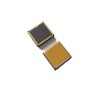INS, full name of Inertial Navigation System, is also referred to as inertial navigation system and sometimes referred to as inertial navigation system. Inertial navigation system is a system which uses gyroscope and accelerometer mounted on the carrier to determine the position of the carrier. Through the measurement data of gyroscope and accelerometer, the motion of the carrier in the inertial reference coordinate system can be determined, and the position of the carrier in the inertial reference coordinate system can be calculated.
Unlike other types of navigation systems, inertial navigation systems are completely autonomous in that they neither transmit nor receive signals from outside. The inertial navigation system must know exactly where the vehicle is at the start of navigation, and the inertial measurements are used to estimate the change in position after starting.
An inertial navigation system contains three accelerometers, each of which is sensitive to acceleration in one direction, usually perpendicular to each other. In order to navigate with reference to the inertial reference coordinate system, the direction of the accelerometer must be tracked. The gyroscope can be used to detect the rotational motion of the carrier with respect to the inertial reference coordinate system, so that the direction of the accelerometer at all times can be determined. With this information, we can decompose the acceleration into the reference coordinate system and integrate it.
Inertial system is an autonomous dead reckoning navigation system which uses inertial sensor, reference direction and initial position information to determine the bearing, position and speed of the carrier. It shall at least consist of an inertial measurement device, a digital computer, a control display device and a dedicated precision power supply. The motion of the carrier is carried out in three dimensional space. Its motion forms are linear motion and angular motion. Both linear motion and angular motion are three-dimensional space. To build a three-dimensional coordinate system, it is necessary to build a triaxial inertial platform. The three axis inertial platform can provide a reference for measuring the linear acceleration of three degrees of freedom. The three linear acceleration components of the known azimuths are measured, and the moving speed and position of the carrier are calculated by computer. Therefore, the first type of inertial navigation system scheme is the platform inertial navigation system. There is no “electromechanical” platform, the inertial component gyroscope and accelerometer are directly installed on the carrier, and a “mathematical” platform is established in the computer. Through complex calculation and transformation, the speed and position of the carrier can be obtained. This electromechanical platform inertial navigation system is the second category of inertial navigation system scheme, which is called strapdown inertial navigation system. According to the different use of core sensors, INS can also be divided into RLG INS, 光纤惯性导航系统、 DTG 惯性导航系统和 MEMS 惯性导航系统。
优点
惯性导航系统具有以下优点:
1、由于惯性导航系统独立于任何外界信息,是一个不向外界辐射能量的自治系统。因此,隐蔽性好,不受外界电磁干扰的影响;
2.惯性导航系统可以在天空、地球表面甚至水下全天候工作。
3.惯性导航系统可以提供位置、速度、方位角和姿态角数据,所得导航信息连续、噪声低。
4、数据更新率高、短期准确、稳定性好。
缺点
1.由于采用组合导航系统, 定位误差随时间增大,长期精度较差;
2、每次使用前需要较长的初始对准时间;
3、设备较贵;
4.无法给出时间信息。
近年来,我国惯性导航技术取得了长足进步。液体浮式陀螺平台惯导系统、动调谐陀螺四轴平台系统先后应用于长征系列运载火箭。 其他小型化捷联惯性导航系统、光纤陀螺惯性导航系统、激光陀螺惯性导航系统以及与GPS校正相匹配的惯性导航系统也已广泛应用于战术制导武器、飞机、舰船、运载火箭、航天器等。 例如,漂移率0.01°~0.02°/h的新型激光陀螺捷联系统在新型战斗机上的试飞、漂移率0.05°/h以下的光纤陀螺和捷联惯性导航系统的应用小型化柔性捷联惯导系统在舰艇、潜艇上的应用,以及小型化柔性捷联惯性导航系统在各类导弹制导武器上的应用,极大地提高了我军装备的性能。













